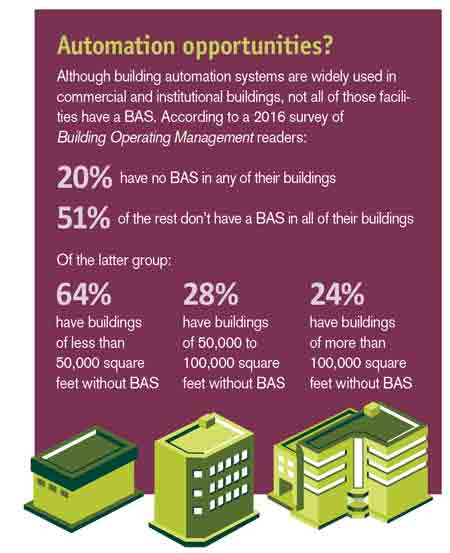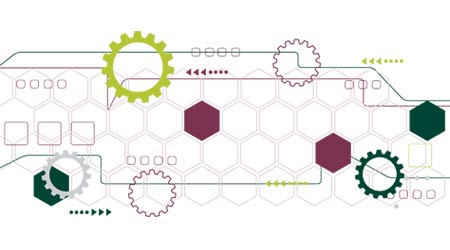How FMs Should Collaborate With IT For Building Internet of Things Implementation
Success with IoT requires blurring the traditional lines between facility management and information technology.
IT-based facility systems, from the traditional building automation system through the latest Building Internet of Things (IoT) offerings, provide many ways to achieve efficiencies. But the new technology takes facility managers into unfamiliar territory — the realm of IT. Facility managers and IT have often had a rocky relationship. Facility managers sometimes believe IT isn’t really concerned about building systems and see IT as an obstacle to getting things done. For its part, IT may view facility management as uncooperative and uninformed about such basic IT principles as cyber security. To take full advantage of all that these new systems and tools have to offer, however, facility managers need the skill set and resources that the internal IT department can provide.
A look at the new generation of Building IoT and BAS technology shows just how IT-centric it is. Controllers are IP-based, user interfaces are Web browsers and mobile devices, and there is integration with IP-based data sources (weather for example) and with other systems and applications using Web-based application programming interfaces, or APIs, explains Paul Oswald, managing director at CBRE | ESI. These IT-based systems present the opportunity to leverage economies of scale in technology and to enable more robust solutions by converging devices and applications onto a common, widely adopted architecture, he says.
“Building systems, including security cameras, HVAC systems, energy management systems, and security systems, which include card keys, building/front desk security, are all IP-enabled,” says Stephen Lipka, chief information security officer, global technology solutions, Cushman & Wakefield. “More than likely, they have been placed on some network — either a building’s local network or the company’s wide-area network.”
While some building systems can stand alone, Lipka says, “the current trend in building management is better energy usage and predictive maintenance, both of which require a wide range of sensors and equipment connected to analytic and management systems.”
The growth of the Building IoT will only increase the importance of connectivity. “IoT has only half its value unless connected to a full software approach: backend database to house and trend the data, integrations to move and aggregate the data, tools to visualize, command, control, and commission the IoT,” says Mitchell Wickland, chief information officer, occupier services, Cushman & Wakefield.
Once building systems are on an organization’s network, “they become primarily IT infrastructure rather than building infrastructure,” says Wickland.
The newer systems actually are rooted in years of controls technology, according to Tom Shircliff, co-founder and principal of Intelligent Buildings, LLC. “For decades manufacturers have been designing their control systems on local area networks (LAN) that require a computer server, a network, software, protocols, and remote connectivity,” they point out in an email.
Today’s BAS and Building IoT tools offer many advantages to facility managers. A good example is fault detection and diagnostic analytics, which are built on rules about how the HVAC system should work. “Some analytics are monetized,” Jim Sinopoli, managing principal at Smart Buildings LLC, explains. “For example, if the damper should be at 10 percent, but it’s at 30 percent, it is wasting energy.” Analytics can look at the fault and assess how much energy is being wasted. “Monetizing some of the faults helps facility management to identify some larger faults rather than some smaller ones,” Sinopoli says.
And there’s no sign that technology developments will slow down. “Under the banner of artificial intelligence,” says Sinopoli, will be “machines that can mimic intelligence and can be used to learn how systems are working and to solve problems.” He calls machine learning the future of building automation.
But this move to IT-based systems has created a challenge for facility managers. “The basic knowledge required to be successful as a facility manager has made a powerful shift toward network connectivity,” says Daryld Karloff, vice president of building services at The Baker Group and a member of the InsideIQ Building Automation Alliance. Smart facility managers “are building strong allegiances with their IT departments,” he says.
The bottom line is that facility management and IT departments in buildings have to work together. “I’ve seen some buildings where they’ve actually put IT people in facility management to deal with data and [related] aspects of IT,” says Sinopoli. Karloff as well says he’s seen the merging of facilities and IT departments “into a single team dedicated to providing the tools, services, and environment to enhance productivity companywide.”
This collaboration shows a shift from the siloed IT and facility management departments of the past. The shift started when IT “realized there were dozens, hundreds and, in some large portfolios, thousands of computers, networks, and remote connections for controls systems that are outside of their enterprise infrastructure and standards,” says Rob Murchison, co-founder and principal of Intelligent Buildings, LLC.
SURVEY SHOWS PLENTY OF OPPORTUNITIES TO IMPLEMENT AUTOMATION

Related Topics:











